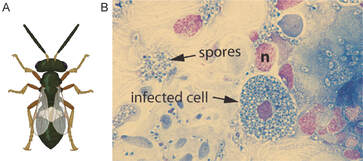Symbiont/Pathogen Evolution
Nosema (Microsporidia: Nosematidae) is one of the most diverse genera of microsporidian pathogens, they are all unicellular, obligate intracellular symbionts that can parasitize a wide range of vertebrates and invertebrates, particularly abundant in insects and other arthropods. Two Nosema species, Nosema apis (N. apis, found in European honeybees, Apis mellifera) and Nosema ceranae (N. ceranae, originally detected in Asian honeybees, Apis cerana), are ubiquitous in honeybees. Nosema parasitism, a serious disease known as Nosemosis, has destructive effects on global apiculture including digestive disorder, poor colony development, reduction in metabolism and reproduction. N. ceranae impairs both health and declining honeybee colonies, it may also damage physical and immune barriers of honeybees, making them more vulnerable to other pathogenic factors. Nosema bombycis (N. bombycis) was found in the domesticated silkworm, Bombyx mori. The silkworm infected by N. bombycis will suffer from a lethal disease called Pébrine and cause serious threat to silk production.
|
Photos of parasitoid wasp and Nosema spores.
(A) Adult Muscidifurax raptor (B) Nosema spores and Nosema in infected cell (from Elke Genersch, 2010) |
Nosema was also discovered in parasitoid wasps genus Muscidifurax raptor (M. raptor, Hymenoptera: Pteromalidae) collected from New York dairy farms in 1990. The microsporidium infected in M. raptor was later described as Nosema muscidifuracis (N. muscidifuracis). Nosema infection significantly affected the development, longevity and progeny production of M. raptor, the parasitoid M. raptor infected by N. muscidifuracis take longer to complete development, live about half as long, and produce about 10% as many progeny as uninfected individuals.
The parasitoid wasps genus Muscidifurax was maintained on commercial Sarcophaga bullata pupae (flesh fly pupae) and at a constant temperature of 25°C and 24h constant light in the Wang laboratory. |
Wang lab firstly assembled a high-quality genome assembly of Nosema infected in the parasitoid wasp species of M. zaraptor using PacBio long-read sequencing. We focused on the investigation of phylogenetic relationship and genome evolution in Nosema-disease fungal pathogen to open new perspectives on symbiont evolution and improve the understanding of epidemiologic patterns of Nosema infection.
Parasitoid wasps genus Muscidifurax are effective biological control agent of filth dipteran flies, including house fly, stable fly, horn fly, black dump fly, and flesh fly. The release of parasitoids with Nosema disease may result in the pathogen infection of field populations where it is not usual. Therefore, it’s important to ensure that only uninfected M. raptor are used for biological pest control. Our high-quality and well-annotated Nosema assembly will facilitate future genome manipulation in Nosema fungal pathogen and provide an effective treatment for controlling Nosema disease in Muscidifurax species.
